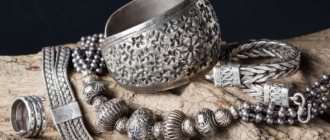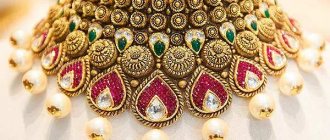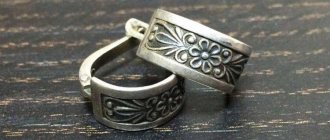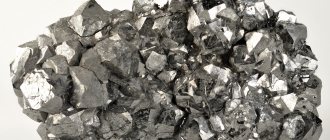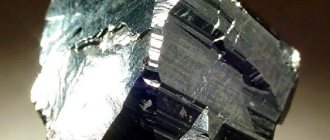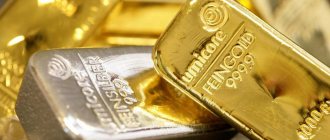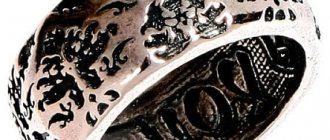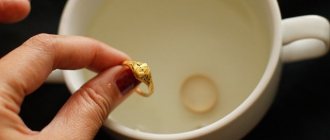Global demand for silver products is growing steadily. However, when looking for the coveted engraving of the quality certificate, many are confused about the difference between the numbers “925” and “965,” and the name “sterling silver” is sometimes even mistaken for “sterile silver.”
What is this seemingly insignificant difference and why is sterling used on such a large scale around the world? Let's analyze the meaning and use of 925 sample point by point.
What it is?
Silver is a soft metal, ductile, malleable and susceptible to external influences. This means that it is easily damaged, it becomes covered with oxide and darkens from sunlight and other external factors. However, a small addition of a diluting metal to the alloy turns it into a standard of beauty and reliability, valued by jewelers for its special qualities.
Over the years, chemists have experimented with adding various cheap metals (zinc, platinum), but nothing has worked better than copper. Today, 925 sterling silver is a white alloy, 1000 grams of which contains 925 grams of silver and 75 grams of copper. It differs from ordinary silver in its durability and resistance to external influences (natural silver is susceptible to corrosion, becomes tarnished over time and becomes covered with a coating of sulfides).
Sterling silver is less ductile, convenient to use and process, does not deteriorate even with daily wear as jewelry and is not affected by sweat, grease, or sunlight. Both precious items and various decorative items are made from it with equal success. In Europe, the production of tableware is especially popular - candlesticks, tea sets, cutlery, etc. Various jewelry is produced all over the world - silver rings with stones, pendants, earrings, crosses and personalized bracelets, engraved coins, etc.
However, the properties of silver are not limited to jewelry. As an element of the periodic table, it is used in technology, medicine and other fields. However, its alloy with 7.5% copper in its composition has firmly established itself in the areas of financial and jewelry activities.
But whether it’s worth following the lead of Chinese manufacturers – we’ll figure it out. Where do legs grow from?
Until recently, counterfeiting silver jewelry was not the most profitable activity - it is, of course, a precious metal, but not the most expensive. “Experiments” with gold brought more profit, and there was no point in wasting time and effort on disguising jewelry “as silver.”
But technology does not stand still, new alloys and methods for processing them appear, so today imitation of silver products in some countries has turned into a profitable business.
However, in Russia, the production of jewelry is under strict state supervision - both modest silver rings and luxurious gold items with precious stones undergo the strictest control. The hallmark that appears on each Solomon ring is not an empty sign: the cost and size of the jewelry do not play a role; the declared proportion of precious metals is confirmed at the highest level.
In Turkey, Egypt and China, the jewelry business is not treated so strictly, and this opens up the opportunity to interpret the concept of “product made of precious metals” in a way that is convenient. To whom? To the seller, of course!
Where did the name come from?
It is difficult to give a definite answer. One of the most common opinions is that the name comes from pounds sterling. The alloy 925 silver has been used for coinage in England since the 12th century, and its percentage has become ingrained in minds as “coin silver.” For centuries, it was valued almost higher than gold and was extremely popular in the global financial market. In the modern world, its currency value is outdated - banks still store bullion, but their value can no longer be compared with the “gold fund”.
However, gold was not lucky enough to capture another, everyday sphere - the practicality of silver alloys was noted from the period of manual everyday use of coins and the value of sterling silver today is expressed in the huge quantity and variability of stored products.
Another version of the origin of the name is easterling silver, which over time was shortened to sterling. It is believed that the alloy, which was used for minting coins, originally appeared in Germany.
One way or another, such a coin alloy has established itself as durable, easy to use, reliable and has gained worldwide popularity, which has survived to this day. Its financial equivalent retains its value in bank bullion, which is now cast exclusively in 999 fineness.
Where to buy
Fans of lunar metal products have their own preferences: some love sparkling white sterling silver, others prefer blackened silver coated with alloys, some are delighted with the mere sight of the openwork patterns of filigree items.
For black silver you will need to go to the northern provinces of Thailand. Chiang Mai craftsmen are famous for their work using the niello technique; in the very center of the city there is a whole block - Walai Road, which is unofficially called the “silver bell district”. Chiang Rai also boasts the products of its craftsmen. This is traditional silver minted by the artisans of the Karen tribe, which is why it is called Karen silver. It is the north of the country that is rich in authentic products; they are found in almost every shop and market. Original products can also be bought in Bangkok; there are several large stores in the Khao San Road area.
In all the resort towns of Thailand, tourists are offered a large assortment of products, but their prices are inflated and truly rare valuable items usually do not end up there. If you are not planning to go to northern Thailand, because... this is quite far and will take a lot of time, then it is better to buy jewelry in official stores or factories where they are delivered during excursions. In this case, you have a better chance of buying a quality product.
You should not buy silver items on the beach, from street vendors, or at huge discounts in strange stalls. Silver is not a fruit to be sold at a price below the market price.
Jewelry from China - what is it?
Given the growing popularity of online shopping, in particular on AliExpress, the choice of products should be treated with special care. Sterling 925 from China often runs the risk of being counterfeited, especially when the buyer is offered an apparently low price.
Often counterfeits involve jewelry that turns out to be simple jewelry. For example, the 925 mark may be on a silver clasp, while the rest of the jewelry, indistinguishable in appearance, will simply be low-grade costume jewelry. Manufacturers are silent about this fact and act simply - the word silver, which refers to the entire product and is perceived by the buyer as a description of the material of manufacture, is in fact just the specified color of the product - “silver”.
Another forgery is the substitution of the concepts “silver” and “coated with silver plating.” The world standard recognizes 3 types of use of silver in coating a product:
- pure silver coating (SP – silver plated);
- sterling silver plated (SSP);
- silver plating over copper (Silver on copper – EPC).
“Omitting” the additional word plated, thereby concealing the fact of coating is an unfair, but quite common infringement of the client’s rights and awareness. The greater the weight of the purchased product, the greater the financial loss from the difference.
However, it is quite easy to distinguish a fake - just scratch the Chinese sterling silver along the surface in an inconspicuous place and find metal of a different shade under the top layer. In this case, the client has every right to return the purchase - however, some online purchases with delivery do not have such an option, and when ordering, the website immediately indicates the impossibility of returning the product due to violation of quality standards.
If the manufacturer lowers the price, does not provide quality certificates (in China there are mandatory product inspections) and does not leave the client the right to return the purchase within 14 days, it is worth considering whether the “precious” alloy being offered is really genuine? It’s a shame to buy only slightly silver-plated jewelry instead of a silver item.
China
The amount of 925 grade silver exported from China is growing every day. This is mainly due to the fact that it is in increasing demand and popularity. According to experts, the quality of the metal imported from China is in no way inferior to products exported from other countries. Therefore, buyers should not be alarmed by the fact that Chinese metal is slightly lower in cost than usual. The cost of a sterling silver product is primarily influenced by the fact that in China the cost of labor is somewhat lower than, for example, in European countries. If you read the reviews, you will notice that all opinions are mostly positive.
There is a known case when a buyer, having received jewelry from China in the mail, did not believe the reviews and went to an expert. The examination showed that the metal was indeed 925, but the stone that was attached to the ring turned out to be of artificial origin. Due to the production of artificial stones, most likely Chinese products (jewelry) are positioned as unoriginal or unnatural.
Prices for this alloy
The world's reserves of natural silver are irreplaceable, which means that its price will only increase over time, like any other limited resource. At the moment, the average price on the world market for 925 sterling silver is at least $0.6 per gram. However, here we are talking about the weight of pure metal - if you add to the cost the work of a jeweler and other components of the cost of the original product, then you should expect at least $4 per gram.
If the proposed cost of the products is lower, then it is worth considering whether you need to buy even a gram of the product if you do not know what grade the alloy is actually, and whether there is a catch here. Perhaps, instead of copper, a cheaper metal was used in the alloy - or the amount of silver is much less than the required 92.5% of the mass. The price for a pure alloy may be more than 60 cents - the cost is not fixed and depends on the country of origin, the complexity of processing the product, etc.
Thai silver
It is known that the concepts of “mysterious Thailand” and “extraordinarily beautiful jewelry” are inextricably linked with each other. Since ancient times, it was Thai silver that was considered an integral attribute of the wardrobe of the fair sex. Silver products from this country are valued all over the world as some of the best. Moreover, making jewelry is a fairly ancient craft in Thailand.
The main reason for the great popularity of Thai silver is low prices and huge reserves of this precious metal in Thailand.
In the 80s, very rich deposits were discovered in the Thai provinces of Chantanaburi and Kanchanaburi, after which the production of Thai jewelry slowly began to increase. Currently, Thailand, as mentioned earlier, is one of the leading leaders in the continuous production of jewelry. Chiang Mai and Bangkok are the two largest centers for the production of silver products. The production of precious jewelry was taken under the strictest state control and that is why the level of silver in all products never falls below 92.7%. Although silver is typically 95 percent silver (.925), it is not that expensive due to the low tax.
The greatest demand is for the products of craftsmen from the northern Thai provinces who work using the niello technique, namely, silver with niello. Boxes, magnificent vases, cigarette cases, knives, skillfully covered with beautiful relief patterns, will not leave you indifferent. The south of Thailand is also not lagging behind in skill. There, various jewelry, tableware, figurines and other valuable goods are cast from silver. It is worth noting that not only tourists, but also local residents are simply crazy about this noble metal. Belts, brooches, cables, chains, buttons, pins and other wardrobe details can be found in the Thai national costume. So, don’t be surprised if you meet some old woman on the street of this country, hung from head to toe with silver jewelry.
Product care
In order for the noble alloy to retain its valuable properties for a long time - pure white tint, shine, unclouded and undamaged surface - appropriate measures are required. Sterling silver jewelry requires attention and care, because even excellent original qualities cannot resist a lot of sun, rubbing, and pollution.
A few simple rules will help you take care of your products:
- Do not perform mechanical cleaning. Even with permanent metal additions, silver still remains malleable and soft, so you can accidentally leave a scratch on it, damage the surface and permanently ruin the appearance of the product.
- It is better to store unused silver in a protected place. It is better to wrap jewelry that will not be worn in the near future in a thick, soft cloth (for example, a velvet bag) and place it where it will be protected from direct sunlight. It is recommended to do the same with utensils used strictly on holidays.
- For cleaning, use a soft cloth and special cleaning compounds. This can be either a ready-made jewelry napkin, pre-impregnated with the necessary substance, or a piece of fabric, which is used to rub silver until it shines after treatment with a mixture of tooth powder, ammonia and hydrogen peroxide. This method is convenient for silverware when a large percentage of the surface needs to be cleaned.
In cases where it seems impossible to get rid of blackening or contamination at home, it is better to seek help from professionals. In a certified jewelry showroom or workshop, silver will be cleaned efficiently without compromising its quality and appearance.
“Tibetan silver” - what is it?
After another debate about what “Tibetan silver” is and how much silver it actually contains, I decided to translate material about this fittings from reviews posted on the Ebay trading platform. So:
Tibetan silver - tips for buyers.
Testing of twelve lots offered for sale on EBay as Tibetan Silver has shown that these lots often contain no silver at all.
Additionally, test results from 2007 found high levels of lead and other hazardous metals such as arsenic.
Because of its attractiveness, fittings sold as “Tibetan silver” are appearing on an increasing number of online marketplaces.
The description seems especially enticing when read online, but the products offered under this designation are far from authentic silver made in the ancient Tibetan style. If you believe that products sold as Tibetan Silver contain any appreciable amount of silver, please read the following information.
Genuine Tibetan silver is usually made from an alloy containing 92.5 percent silver. The remaining 7.5 percent is most often occupied by copper.
In contrast to this silver, much of what is now sold as "Tibetan silver" does not even come close to its quality.
The actual silver content of "Tibetan silver" may be around 1 or 2 percent, and/or the base material may actually be tin, zinc, copper or nickel alloys, which determines the low price.
The samples tested, sold as Tibetan silver and purchased on Ebay and Etsy (two were shipped directly from China, the rest from the United Kingdom, Australia and the United States), did not contain any silver at all.
Instead, the dominant metals in the six samples were nickel, copper and zinc. The seventh sample, sent from Hong Kong, contained 1.3% arsenic and 54% lead, a highly toxic and carcinogenic substance.
Additional tests of "Tibetan silver" were carried out in April 2009. Five different samples were used, purchased at random from three different eBay sellers offering Tibetan silver. You can see the results in the table. Note that only sample 5 contained more than 1 percent silver.
Sample 1 2 3 4 5 Copper 25.6 31.98 61.21 36.30 45.08 Nickel 7.02 5.29 Zinc 66.35 61.49 38.01 62.94 7.67 Silver 0.35 0.24 0.0004 0.14 1.23
The other metal content of the samples was composed of traces of chromium, aluminum, tin, gold and lead. Unlike tests since 2007, these samples did not show significant lead content.
Recall that high levels of lead in adults cause increased blood pressure, reproductive problems, nervous disorders, muscle and joint pain, irritability, and memory loss. Children are even more susceptible to lead, and even very low levels can lead to learning disabilities, attention deficit disorder and behavior problems, growth retardation, hearing impairment and kidney problems.

